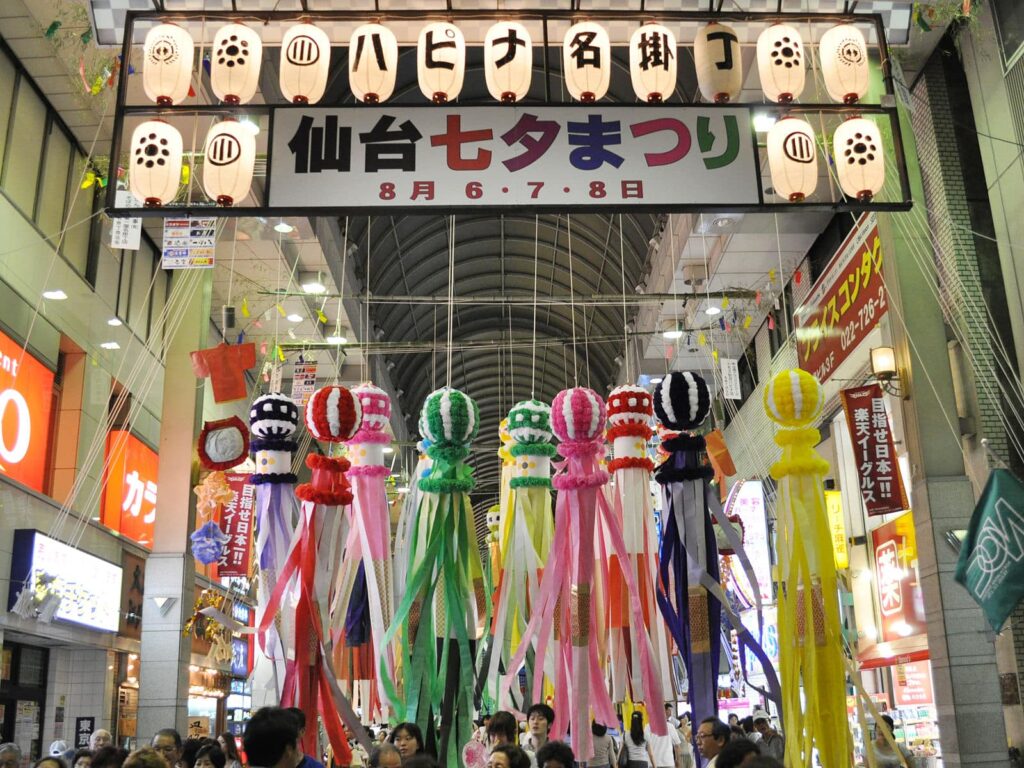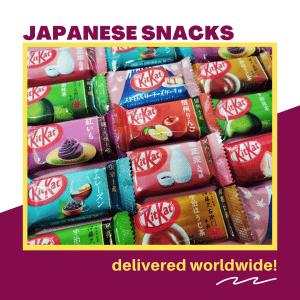[ad_1]
As one of the historic five seasonal holidays (gosekku, 御節句), Tanabata has an important place in the cycle of the year. The five seasonal holidays are, in order, New Year’s (Oshogatsu, お正月), Doll Day (Hinamatsuri, ひな祭り), Children’s Day (Kodomo no hi, 子供の日, formerly Boys’ Day), Tanabata, and the now less famous Chrysanthemum Day (Kiku no hi, 菊の日).
Much of modern Japan observes Tanabata on July 7th. On that day, people decorate bamboo trees and tie wishes to their branches on narrow cards (tanzaku). It is a holiday that has always been observed with pomp, wish-making, and general revelry. But our modern July 7th is not the old 7-7 as understood by Japan’s pre-modern recocking; August 7th is. And some places in Japan preserve the old seasonality of Tanabata by observing it in early August. Sendai is a notable example of just one such place.
Decorations Explained
Sendai Tanabata boasts seven decorations. They represent wishes for success and traditionally, and for improvement in skills (especially practical skills) over the year ahead.

Paper wish cards called tanzaku (短冊) are part of Tanabata regardless of where in Japan the festival is observed. People write a wish on a narrow, colorful card and tie it to small bamboo branches set up for the occasion. In Sendai Tanabata specifically, they also represent wishes to improve in penmanship and scholarship. This part of the Tanabata festivities in Japan overall is now so ubiquitous that it’s even received its own emoji. The emoji first appeared in 2010 as part of Unicode 6.0 and was then released in Emoji 1.0 in 2016. Exactly how it’s displayed may depend on your device of choice in viewing this article, but it’s the following emoji: 🎋.
Paper kimono (kamigoromo, 紙衣) represent wishes to keep healthy and to gain skill in needlework.
Paper cranes (orizuru, 折鶴) represent wishes for long life, as cranes in general do, as well as safety in the home.
An origami purse (kinchaku, 巾着) represents wishes for business prosperity and learning thrift.
The casting net (toami, 投網) represents wishes for an abundant catch.
A latticework wastepaper basket (kuzukago, 屑篭) represents the desire for cleanliness.

Finally, as noted again below, the fukinagashi (吹き流し), papier-mache decoration with long, trailing streamers, is one of the most visible symbols of Tanabata in Sendai. They’re set up in hopes of improving in skill; traditionally, in handicrafts and weaving. But a recent addition to this, starting in Sendai Tanabata’s initial postwar resurrection, is the decorative ball of flowers at the top (kusudama くす玉). One explanation of its origins ascribes it to the work of an enterprising Sendai merchant in the early postwar years. The merchant saw dahlias growing in his garden and felt moved to use them in his Tanabata decorations, and others took inspiration.

History and Changes
Sendai’s Tanabata– locally known in the Edo period as Tanabata-san– dates to the city’s early 17th century foundations as the Date clan’s castle town. Date Masamune, the city’s founder who was also the first lord of Sendai domain, wrote eight poems about the holiday. One of them, from Genna 6 (1618) says:
「七夕は としに一たひ あふときく さりてかへらぬ 人のゆくすえ」
It is said that Tanabata/Comes but once a year/So too, people’s fates/Passing and not returning.
The festival was originally observed on the lunar 7/7 as elsewhere, with the decorations taken down and floated down the city’s rivers on the morning of the 8th. But during the tumultuous, cash-strapped reign of 7th generation Sendai daimyo Date Shigemura (1742-1796, r. 1759-1790), the holiday was moved up by a day. Under the new system, decorations went up on the night of the 6th and set adrift in the rivers on the morning of the 7th. According to sendaitanabata.com, the reason for this one-day shift is likely because Date Shigemura’s twelfth daughter Ryuu died suddenly at 8 years of age just before Tanabata. Her funeral arrangements conflicted with this seasonal festival. Despite this likely sad reason for it, that shift of the observance on the calendar presaged the holiday’s current format of starting a day earlier than usual by nearly two centuries.
Early-Modern Sendai Tanabata
In Yakutaigusa, a journal of 13th generation Sendai daimyo Date Yoshikuni (1825-1874, r. 1841-1868), we see an outline and brief history of the holiday as it was observed in the late Edo-early Meiji transition.

Yoshikuni wrote Yakutaigusa in the very early Meiji era, just before his death, while under house arrest in Tokyo. For his role in leading Sendai domain and the Northern Alliance during the Boshin War, the imperial government ordered Yoshikuni’s retirement and seclusion following Sendai domain’s defeat in late 1868. Unlike most daimyo, who were born in Edo and therefore had less of an emotional tie to their domains, Yoshikuni was born in Aoba Castle and spent his early childhood in and around Sendai. In Yakutaigusa, his homesickness in exile is, in my opinion, apparent.
“The 7th of the 7th month is called Tanabata.
From the evening of the 6th to the morning of the 7th, five-colored tanzaku are inscribed, or alternatively in summer fan-shaped style, made by women and children. Things are tied to small bamboo and raised upon the eaves, to celebrate the two stars. Those small bamboo are sure to be taken down and set adrift in a river on the morning of the 8th. It is the same custom everywhere. But in Sendai, on the night of the 6th, this is observed. The custom is to set the bamboo adrift from Hyōjōbashi Bridge on the dawn of the 7th.
When inquiring about the origins of this, since Lord Shigemura’s time there was a conflict of observances and thus no seasonal festival on the 7th. Thus in deference, the festival of the two stars was on the 6th. These are matters of long ago times, and cannot be surmised in this day and age, but they seem to be why this was done.
Now on Tanabata, women and children offer this song, though its author is unknown.
七夕の願の糸を引かけてこよひそいのる星合の空
Tanabata no/negai no ito o/hikikakete/koyohiso inoru/hoshiai no sora
Hanging the threads/of Tanabata wishes/Tonight, then, we pray/to the meeting-stars’ sky”
Decline and Revival
The imperial army vanquished Sendai domain in the Boshin War and left swaths of the northern Tohoku region in disarray. The ruinous state of Tohoku in defeat was also part of what cemented its image, starting from the early days of modern Japan, as a region of uncultured boors. This was followed shortly by the Meiji government imposing a switch of calendar system from lunar to Gregorian in 1873. This prompted many parts of Japan, but not all of them, to shift the calendar of seasonal observances and shrine rituals to preserve their number on the calendar, rather than have them stay where they were and take on a different date. Thus, “7-7” translated to early August, but many places in Japan simply opted to observe Tanabata in July, the Gregorian calendar’s 7th month.
The old Sendai Tanabata dwindled and faded through the Meiji era, especially in the new era of straitened economic times following World War I and into the Great Depression, though it did not vanish entirely. Indeed, it was in that period of decline that in Showa 3 (1928), the holiday’s present date range– 6 to 8 August, preserving the seasonality of the old festival– was set.
During the Pacific War, Sendai Tanabata was not observed, and in the summer of 1945, the US Army Air Forces firebombed downtown Sendai itself. The setting for the liveliest of the festivities lay in ashes. It might seem that that would’ve been the end, but as is often the case with Sendai– as you may recall from my recent article about the statue of Date Masamune– decline, war, and destruction were not the end of the story.
A Celebration of Hope
In 1946, on Ichibanchō-dōri avenue in the bombed-out ashes of Sendai’s Ichibancho district, the first postwar Sendai Tanabata decorations went up. These were the sasakazari (bamboo decorations), of which the fukinagashi, with its papier-mache construction and long streamers, is an especially eye-catching sight. Kahoku Shinpō, the Sendai-based newspaper that remains the north’s paper of record, reported on August 7, 1946, 「10年ぶりの”七夕祭り”涙の出るほど懐かしい」“The first Sendai Tanabata in a Decade: Nostalgic to the Point of Tears.”
The Showa Emperor’s 1947 visit, taking place during his series of postwar tours nationwide, was the catalyst for the festival really taking off. The city set up 5000 sasakazari in a seven-colored arch to welcome the emperor.
This was the start of today’s Sendai Tanabata festivities. The observance was back for good, out of a combination of both local pride and a desire to cultivate what very quickly became a tourist draw from across Japan, and – until the COVID-19 pandemic – also from overseas. Even before the war, Miyagi Prefecture and the Tohoku region were sorely in need of an economic boost. After the war, tourist draws like Sendai Tanabata helped further the city’s reconstruction and rebirth.
Sendai Tanabata today
Today, Sendai Tanabata remains arguably one of the most recognizable symbols of Sendai, and is still a tourist draw every August. It is regarded as one of the Tohoku region’s three great festivals, together with the Aomori Nebuta and Akita Kantō Festivals
The pandemic has put a bit of a damper on the festivities, but as of this writing, it is still on, and social media is abuzz.
If you’re able to make the trip, then I encourage you to go to Sendai for Tanabata. Make a wish, enjoy the iconic decorations, and especially in these difficult times, take strength from this holiday: lost, found, gone, and restored again.
It’s a story worthy of Orihime and Hikoboshi’s celestial saga itself.
And for my part, as I close this article after a month in recovery from COVID and seventeen years away from Sendai, my wish will be the same as it has always been.
Next year in Ichibanchō.
Author’s note: my thanks to Sharon Domier, MLIS for her help in finding a digitized source for Date Yoshikuni’s Yakutaigusa.
Works Cited
- “Calendar History.” The Japanese Calendar. National Diet Library, Accessed 5 August 2022.
- Date Yoshikuni 伊達慶邦. “Yakutaigusa” やくたい草․ pp. 73-88 of Sendai Sōsho Vol. 18 仙臺叢書第18巻. (Sendai: Tohoku Kappansha 東北活版社, 1936), p. 77. [Archived at the National Diet Library.] Accessed 5 August 2022.
- Hearn, Lafcadio, and Bruce Rogers. The romance of the Milky Way : and other studies & stories. (Boston: Houghton Mifflin, 1905), pp. 16-20. [Archived at Archive.org] Accessed 5 August 2022.
- Miyagi Kenshi Vol. 2 宮城県史第2巻 (Sendai: Hōbundō 宝文堂, 1966), p. 661.
- Ōyama Kashiwa 大山柏. Boshin no Eki Senshi 戊辰の役戦史, Volume 2. (Tokyo: Jiji Tsūshinsha 時事通信社,, 1988), pp. 874-875.
- R.H.P. Mason et. al., A History of Japan: Revised Edition. (Rutland, VT: Charles E. Tuttle Company, 1997), pp. 52-62.
- “Sendai Tanabata to wa? Sono tokuchō o goshōkai.” 「仙台七夕とは?その特徴をご紹介。」Sendai Tanabata Matsuri. Accessed 5 August 2022.
- “Yonhyakunen no rekishi o hokoru, Sendai Tanabata o Goshōkai.” 「400年の歴史を誇る、仙台七夕をご紹介。」Sendai Tanabata Matsuri. Accessed 5 August 2022.
[ad_2]
Source link



